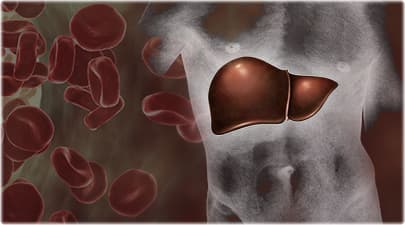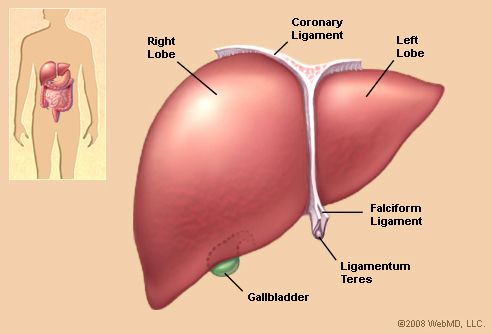Berikut kutipan ilmiah kedokteran tentang kesehatan hati atau liver yang sangat bermanfaat sehingga disusun dan digunakan sebagai referensi pribadi.

What doesn't your liver do? Besides taking toxins out of your blood, your liver has about 500 jobs, including making bile -- a liquid that helps you digest food. Your liver takes what you eat and drink and turns it into energy and nutrients; it helps your body use carbs, for example. It also plays a role in helping your blood clot.
A wedge-shaped organ, your liver is about the size of a football. Weighing in around 3 pounds, it's your largest organ -- other than your skin. It’s on the right side of your body, just under your rib cage.
Previou.
Doctors use blood tests to check the liver for injury, disease, or infection. These are usually a series done at the same time. Your doctor might call them a hepatic function panel or liver profile.
Previou
The liver is the only organ that can grow back when part of it is damaged or removed. That's why people are able to donate parts of their livers. You don't have to be related to someone to give them part of your liver, although most donors are usually relatives or close friends.
Previous.
Some people go on "cleanses" -- limiting their diets to certain juices or foods, hoping to wash away toxins from their livers. There's no scientific proof that these detox diets work. Instead, a healthy diet will give your liver the nutrients it needs.
Your liver breaks down the alcohol you drink to help get it out of your body. But drinking more alcohol than your liver can process may cause damage. There are several types of alcohol-related liver disease: fatty liver disease, alcoholic hepatitis, and alcoholic cirrhosis. If you find it hard to cut back on alcohol, ask a doctor or counselor for help.
Taking too much acetaminophen (Tylenol) can cause serious liver damage. It can be found in more than 600 medications, including prescription drugs and many over-the-counter pain, cold, and cough remedies.
For adults, the daily limit of acetaminophen is equal to six extra-strength Tylenol tablets from all sources combined. Read the ingredients carefully, and follow the directions on the label and your doctor's advice. If you're taking that much Tylenol for more than 2 weeks, talk to your doctor.
Your skin and eyes can turn a yellow shade when there's too much of something called bilirubin in your blood. Bilirubin is a yellow pigment your body makes when it breaks down red blood cells. Normally, the liver filters out bilirubin. But if you have too much of it or if you have liver damage, you can get jaundice.
Hepatitis A is one example of an illness that results in jaundice. Also, newborns often have jaundice because their livers are still developing, and they have trouble filtering the bilirubin.
Cirrhosis, scarring of the liver with worse function, is the most serious type of liver disease. Though alcohol can contribute to cirrhosis - up to 1 in 5 heavy drinkers gets it - it can also result from hepatitis B or C, among many other causes. You can't reverse liver damage from cirrhosis.
Drinking less alcohol can help prevent liver problems. If you have a drinking problem, seek help to quit. There are other things you can do for your liver, too. Get to a healthy weight with exercise and a well-balanced diet. Also, consider getting tested to see if you have hepatitis C. The CDC suggests you get tested if you're a Baby Boomer, if you ever used IV drugs, or if you had a blood transfusion before 1992. Ask your doctor if you should get vaccinated against hepatitis A and B, too.
Liver disease can be silent for a very long time. As many as half of people who have it don't have any symptoms at all. If you do have warning signs, they're often vague, like being really tired and having achy muscles. You may also have itchy skin, swelling in your belly, dark urine, confusion, or yellowing of the eyes or skin. You'll need to see a doctor for blood tests to find out for sure if your liver is the problem.
There is a vaccine for hepatitis B, but not for hepatitis C. In the U.S., the hepatitis B vaccine is given to all babies and children, as well as most adults. It’s given as a series of three shots over 6 months.
Hepatitis C is usually spread by blood, either through a hospital needle-stick accident or sharing needles when injecting drugs. It can be spread from an infected mom to her baby during birth. It can sometimes be spread during sex. The rule of thumb is that if you're at risk for an STD, you're also at risk for hepatitis. If you're with more than one partner - or someone who may have been infected - so always use condoms.
Some fat in your liver is normal. But if it makes up more than 5%-10% of the organ's weight, you may have fatty liver disease. If you're a drinker, stop. That's one of the key causes of the condition.
There are two main types of fatty liver disease:
- Alcoholic liver disease (ALD)
- Nonalcoholic fatty liver disease (NAFLD)
You can also get fatty liver disease during pregnancy.
Alcoholic Liver Disease (ALD)
You can get alcoholic liver disease from drinking lots of alcohol. It can even show up after a short period of heavy drinking.
Genes that are passed down from your parents may also play a role in ALD. They can affect the chances that you become an alcoholic. And they can also have an impact on the way your body breaks down the alcohol you drink.
Other things that may affect your chance of getting ALD are:
- Hepatitis C (which can lead to inflammation in your liver)
- Too much iron in your body
- Being obese
Nonalcoholic Fatty Liver Disease (NAFLD)
It's not clear what causes this type of fatty liver disease. It tends to run in families.
It's also more likely to happen to those who are middle-aged and overweight or obese. People like that often have high cholesteroland diabetes as well.
Other causes are:
- Medications
- Viral hepatitis
- Autoimmune or inherited liver disease
- Fast weight loss
- Malnutrition
Some studies show that too much bacteria in your small intestine and other changes in the intestine may be linked to nonalcoholic fatty liver disease.
Acute Fatty Liver of Pregnancy
It's rare, but fat can build up in your liver when you're pregnant. This could be risky for both you and your baby. It could lead to liver orkidney failure in either of you. It might also cause a serious infection or bleeding.
No one fully understands why fatty liver happens during pregnancy, but hormones may play a role.
Once you get a diagnosis, it's important that your baby gets delivered as soon as possible. Although you may need intensive care for several days, your liver often returns to normal in a few weeks.
Symptoms of Fatty Liver Disease
You might have fatty liver disease and not realize it. There are often no symptoms at first. As time goes on, often years or even decades, you can get problems like:
- Feeling tired
- Loss of weight or appetite
- Weakness
- Nausea
- Confusion, poor judgment, or trouble concentrating
You might have some other symptoms, too. Your liver may get larger. You could have a pain in the center or right upper part of your belly. And the skin on your neck or under your arms may have dark, colored patches.
If you have alcoholic liver disease, you may notice that the symptoms get worse after a period of heavy drinking.
You could also get cirrhosis, a scarring of your liver. When that happens, you might have:
- Buildup of fluid in your body
- Wasting of your muscles
- Bleeding inside your body
- Jaundice (yellowing of skin and eyes)
- Liver failure
Diagnosis of Fatty Liver Disease
You might find out that you have the disease when you get a routine checkup. Your doctor might notice that your liver is a little larger than usual.
Other ways your doctor might spot the disease are:
Blood tests. A high number of certain enzymes could mean you've got fatty liver.
Ultrasound. It uses soundwaves to get a picture of your liver.
Biopsy. After numbing the area, your doctor puts a needle through your skin and takes out a tiny piece of liver. He looks at it under a microscope for signs of fat, inflammation, and damaged liver cells.
Treatment of Fatty Liver Disease
There is no specific treatment. But you can improve your condition by managing your diabetes, if you have it.
If you have alcoholic liver disease and you are a heavy drinker, quitting is the most important thing you can do. Talk to your doctor about how to get help. If you don't stop you could get complications like alcoholic hepatitis or cirrhosis.
Even if you have nonalcoholic fatty liver disease, it can help to avoid drinking. If you are overweight or obese, do what you can to gradually lose weight -- no more than 1 or 2 pounds a week.
Eat a balanced and healthy diet and get regular exercise. Limit high-carb foods such as bread, grits, rice, potatoes, and corn. And cut down on drinks with lots of sugar like sports drinks and juice.

Front View of the Liver
The liver is a large, meaty organ that sits on the right side of the belly. Weighing about 3 pounds, the liver is reddish-brown in color and feels rubbery to the touch. Normally you can't feel the liver, because it's protected by the rib cage.
The liver has two large sections, called the right and the left lobes. The gallbladder sits under the liver, along with parts of the pancreas and intestines. The liver and these organs work together to digest, absorb, and process food.
The liver's main job is to filter the blood coming from the digestive tract, before passing it to the rest of the body. The liver also detoxifies chemicals and metabolizes drugs. As it does so, the liver secretes bile that ends up back in the intestines. The liver also makes proteins important for blood clotting and other functions.
Liver Conditions
- Hepatitis: Inflammation of the liver, usually caused by viruses like hepatitis A, B, and C. Hepatitis can have non-infectious causes too, including heavy drinking, drugs, allergic reactions, or obesity.
- Cirrhosis: Long-term damage to the liver from any cause can lead to permanent scarring, called cirrhosis. The liver then becomes unable to function well.
- Liver cancer: The most common type of liver cancer, hepatocellular carcinoma, almost always occurs after cirrhosis is present.
- Liver failure: Liver failure has many causes including infection, genetic diseases, and excessive alcohol.
- Ascites: As cirrhosis results, the liver leaks fluid (ascites) into the belly, which becomes distended and heavy.
- Gallstones: If a gallstone becomes stuck in the bile duct draining the liver, hepatitis and bile duct infection (cholangitis) can result.
- Hemochromatosis: Hemochromatosis allows iron to deposit in the liver, damaging it. The iron also deposits throughout the body, causing multiple other health problems.
- Primary sclerosing cholangitis: A rare disease with unknown causes, primary sclerosing cholangitis causes inflammation and scarring in the bile ducts in the liver.
- Primary biliary cirrhosis: In this rare disorder, an unclear process slowly destroys the bile ducts in the liver. Permanent liver scarring (cirrhosis) eventually develops.
Sumber : MD
Tidak ada komentar:
Posting Komentar